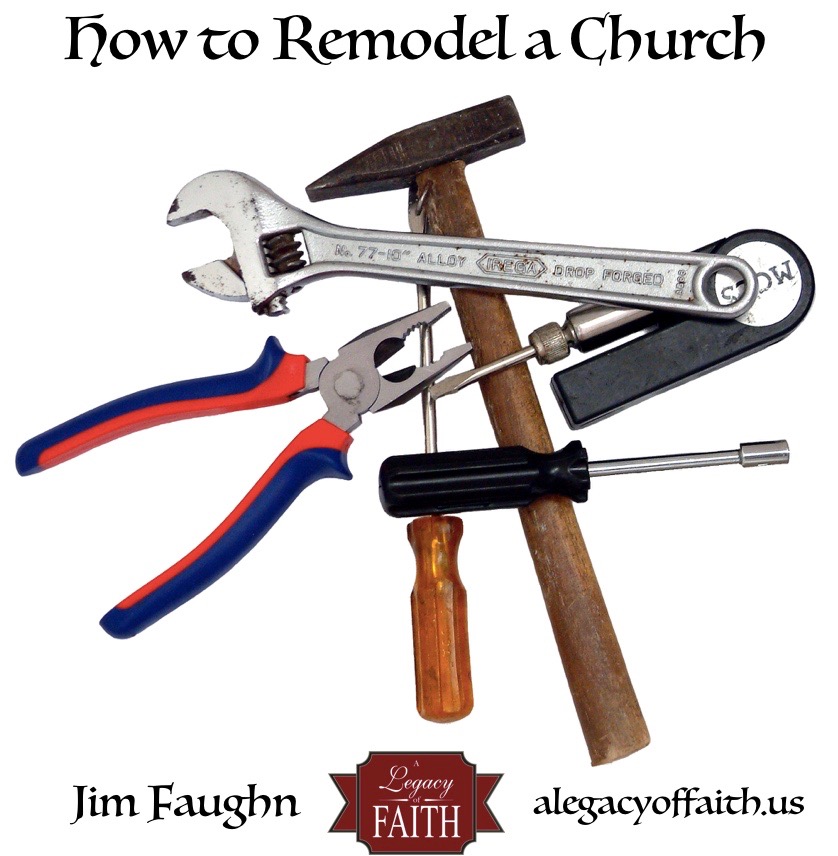How to Remodel a Church

Most of us are familiar with the little hand exercise that begins with: here is the church; here is the steeple. Depending on whether or not we have our fingers interlocked, it may end with: open the door; where’s all the people – or – open the door; there’s all the people.
If only it were that simple. If only the church and the people were two different things, life might be so much more simple. “Church problems” could be fixed with hammers, saws, paint, etc. if the church really was only a building.
I fully understand that, when many people think of the word “church,” they think of a building. To be sure, our Lord did say that He would build His church in Matthew 16:18. When Paul wrote the letter to the Ephesians, he penned these words: “…you…are built on the foundation of the apostles and prophets, Christ Jesus Himself being the cornerstone” (Eph. 2:19-20).
As that passage continues, the Holy Spirit inspired Paul to use words and phrases like “structure” (v. 21), “built together” (v. 22), and “dwelling place” (v. 22). It is beginning to sound like the church is, in fact, a building, doesn’t it?
However, the key word in the text to which we have referred may be the word “you.” To whom (or to what) were these words addressed?
As the epistle to the Ephesians begins, we find the answer. This epistle is addressed “…to the saints who are in Ephesus, and are faithful in Christ Jesus” (Eph. 1:1).
The letter is addressed to people.
The church is composed of people.
The church is not made of wood, metal, bricks, mortar, wiring, plumbing, etc. The church is people.
The church is people who are not all alike.
As I type these words, I am thinking of the particular church family of which I am blessed to be a member and in which I serve as one of the elders. We are a diverse group.
As one would look around during one of our assemblies, he/she would see a variety of skin colors. We do not all have the same religious background. Some “grew up in the church.” In fact, some grew up in this particular congregation. Others have come from other religious backgrounds or no religious background at all.
If you include those who are too young to be Christians, we have people who have not yet begun their public or home school experience. At the same time, there are those who have completed years and years of formal education. We live in six different counties in two different states. (I recently discovered that one man who has been visiting on a regular basis has just begun the process of becoming a naturalized U. S. citizen.)
Where I worship, there are some fairly large extended families and there are some who have no other person there with whom they are related. There are those “in the prime of life” and those who are struggling with some debilitating effects of either aging or disease (or both). Some of us are fairly “well off” financially, while others of us are “struggling to get by.”
I could go on and on with how diverse one congregation can be, but that is not what is on my mind at this time. What I am thinking about presently has to do with the challenges and opportunities this diversity provides.
Unlike building materials, people have feelings. We can (and do) get hurt from time to time. We have opinions. Those opinions differ from time to time. We have emotions. Since we are all different, we cannot all expect to be happy, sad, excited, concerned, etc. at the same time. Each one of us has his/her individual preferences. It would border on foolish to think that even two people would have the exact same list of preferences on everything.
So – what does all of this mean?
At least in part, it means that there are no “quick fixes” to challenges that are bound to arise within a local congregation of God’s people. A new coat of paint will not cover up a problem. Replacing the flooring won’t solve anything. A proper solution for stresses that may arise will not be found in a new roof, updated plumbing, a revamped electrical system, etc.
“People problems” cannot be solved with building materials. Some other solution must be found. Some other solution is available.
It is interesting to me that, in the same letter in which Paul used “building terms,” he also was very aware that he was writing to people. He did not use building terms to address people problems. He did, however, write something in that same letter that would go a long, long way in preventing and/or solving problems that arise from time to time.
Some of us like to preach and teach a great deal on “the seven ones of Ephesians 4:4-6.” It is my firm belief that people outside of Christ will not care much about those seven ones until and unless they see those who claim to be His people practicing what they read in Ephesians 4:1-3.
I therefore, a prisoner for the Lord, urge you to walk in a manner worthy of the calling to which you have been called, with all humility and gentleness, with patience, bearing with one another in love, eager to maintain the unity of the Spirit in the bond of peace (Eph. 4:1-3).
I am not, by any stretch of anybody’s imagination, a handyman. I am, however, a Christian. As such I pray that I will use the “tools” I have at my disposal to build and repair; not to damage and destroy.
If a church needs to be remodeled, that project might need to begin with me. I might need to check my attitude, my level of involvement, and my dedication to the One whose name I wear.
To Receive Every Post from A Legacy of Faith through Email for Free, Click Here
AUTHOR: Jim Faughn


